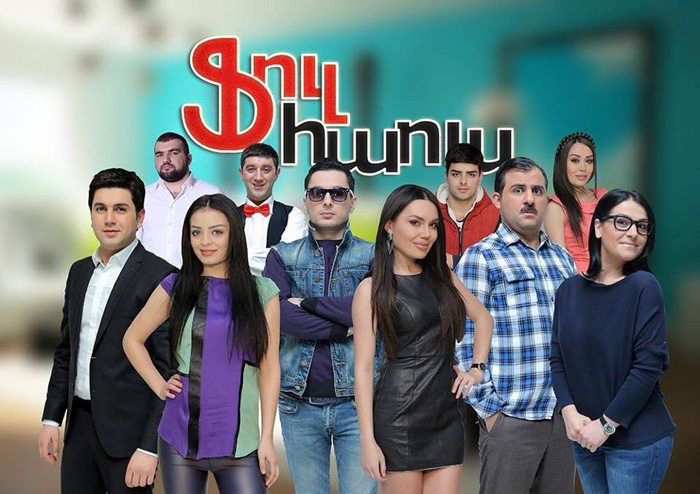By Sarmad Iqbal
Special for the Armenian Weekly
Barev dzez (hello), to all my Armenian friends who will be reading my love letter to their country’s pop music and TV series.
Although my country, Pakistan, doesn’t have any sort of formal diplomatic relations with Armenia because of diplomatic pressures on Pakistani leaders from Armenia’s adversaries Turkey and Azerbaijan, I have been in love with your great nation Armenia.
Armenia for me isn’t just a country surrounded by hostile neighbors like Turkey and Azerbaijan, or a country that Kardashians, Cher, and Charles Aznavour have made popular globally. Armenia for me is a cradle of civilization, a land of unspoiled beauty with its snow-peaked mountains, lush green valleys, and life-giving rivers (which I have seen in different online documentaries about Armenia, out of my curiosity to know more about your great nation).
Armenia is a land that has been continually invaded by different civilizations and has been a battlefield for rival empires, but has maintained its character and nature in the midst of all invasions and all attempts by outsiders to eradicate the identity of Armenians. Greater attempts to eradicate Armenia from the map of the world and to deprive Armenians of their identity resulted in greater resistance from sons and daughters of your great nation to safeguard their national identity and motherland. Armenians showed to the world that the use of physical force and power is not adequate to extinguish their passion and devotion for their nation.
I have always been quite curious and eager about exploring Armenia, as it is a country with which my country’s relations are almost nonexistent, and that nonexistent part was enough to augment my curiosity to explore Armenia. However, I cannot travel to Armenia as a Pakistani citizen because of nonexistent Armenia-Pakistan relations and nonexistent Armenian embassies or consulates (or anything pertaining to your beautiful nation) in Islamabad, Lahore, Karachi, and other cities of my country.
Because of all such barriers to accessing Armenia and Armenians, I decided to explore Armenia (a country that many in my country do not even know exists on the world map) through the medium of music and TV series. I have been vehemently against all the anti-Armenian one-dimensional and biased coverage of Nagorno-Karabagh (Artsakh) conflict between Armenia and Azerbaijan by my country’s media, and that biased media coverage also played a pivotal role in my exploration of what Armenia really is. Is it really such a “bad” country? The only thing reported about Armenia in Pakistani newspapers or news channels, and only too occasionally, is that “Armenia is killing Azerbaijani brothers of Pakistan.” That biased media coverage also irked me and furthered my curiosity to explore Armenia. Armenian pop music and TV series, like Full House, were my only resort to exploring an Armenia that is different from the one portrayed in Pakistani, Turkish, and Azerbaijani media.
My first-ever foray into Armenian culture was through Armenian pop music and songs of singers like Lilit Hovhannisyan, Mihran Tsarukyan, Lusine Poghosyan, Gaby Galoyan, and Hripsime Hakobyan.
One day, while I was looking for some new song of Katy Perry’s on YouTube, I came across “Es Em Horinel” by Armenian pop singer Lilit Hovhannisyan, and that song was even better than the Katy Perry song I was looking for. And that is when my exploration of Armenia started, along with the eradication of all the stereotypes I had heard about Armenia and Armenians. Lilit had a mesmerizing voice that soothed me, and I practically had ear orgasms even though the song melodiously sung by Lilit wasn’t in my native language or in a language I can fathom easily; it was in Armenian, and from then onward I also fell in love with the Armenian language.
I then also started studying Armenian, and I found this ancient and legendary language full of beauty as its speakers are. I also started eagerly discovering the historical background of Armenian, and I was astounded when I discovered that Armenian thrived in Europe, Russia, and elsewhere in the world where Armenians were living before the creation of an independent state of their own, before Armenian independence from the USSR in 1990s. I also found Armenian more fascinating when I found out that Armenian has similarities, and shares many words with, Iranian Farsi, as Farsi has so many words in common with my native language and mother tongue, Urdu (the national language of Pakistan), and there is a strong Iranian influence on Pakistani culture, alongside the influence of Indian and Arab cultures.
Armenian has the word sug for “grief,” and both Farsi and Urdu also have soog for grief, which shows how we are connected through our respective languages, even though the link between Armenian and Urdu is distant and there is an intermediary, Farsi. But it still connects us somehow, despite almost nonexistent Armenia-Pakistan relations and Pakistan’s not recognizing Armenia as a state. Other words in common* between Armenian and Urdu include the word for time, vaght, as Armenians call it, while we Pakistanis call it waqt. We have the word jawan for young, similar to jivan in your jahel-jivan. We also have the word for the color orange in common, as you have narinj and Pakistanis have naranji in Urdu. You have nshan for sign and we have nishan in Urdu. You have the word tag for crown, and we have the word taj.
Tsavum yem (I am sorry) for deviating a bit from the topic of my article, which is about my love for Armenian pop music and TV shows, and I hope I will be able to write an entire article on the common words between Armenian and Urdu after this article for Armenian Weekly.
After listening to several songs of Lilit Hovhannisyan, including “De El Mi” (in which she had an Indian Bollywood theme to her song video), I was more mesmerized and allured by Lilit’s magical, melodious voice. In “De El Mi,” it seemed as if Lilit isn’t from a country far from Pakistan, but a familiar Bollywood diva who dances as if she is the sweetheart of millions and as if the stage is her paradise on Earth. Lilit did not seem too foreign in that music video of “De El Mi” to me, and she danced like Bollywood queens, such as Deepika Padukone and Priyanka Chopra.
I know some Armenian friends reading this must be astonished over my going easy with Bollywood, which is an Indian movie industry, whereas India is perceived globally as not on good terms with, and arch-rival of, Pakistan, but that is all the rubbish spread by politicians for their own benefit; the public in Pakistan and India love each other, and in fact Pakistanis are as big fans of Bollywood as their Indian counterparts.
After songs like “De El Mi,” “Es Em Horinel,” “Te Axjik Lineyir,” and “Indz Chspanes,” I also came across another melodious hit of Lilit’s, “Te inchu em qez sirum” (Why do I love you) with another Armenian pop star and charming actor Mihran Tsarukyan, and that song has been pivotal in healing me whenever I feel sad or whenever I confront some problem or a stressful tribulation. Their duet of magical voices has always been enough to heal me and take me out of gloomy stress.
Apart from Mihran’s brilliant singing, I also fell in love with his acting in my favorite Armenian TV series, the comedy-drama Full House, in which he played the role of Arsen Grigoryan, who is Lika’s (Lika is the boyfriend of one of the main characters of the series, played by the stunning Armenian actress Arpi Gabrielyan, in Seasons 4, 5, and 7). This TV series gave me further insight into the daily lives of Armenians enjoying their lives—and not always fighting some war or doing something “bad” as portrayed by the media here. Apart from Mihran Tsarukyan and Arpi Gabrielyan, in this TV series I also relished the acting of Gor Hakobyan as Feliks, who was Tatev’s (played by actress Ani Yeranyan) boyfriend from Season 5 onward. I also relished a scene in one episode (I have unfortunately forgotten which), where Lika and Arsen and some other characters dance to a hit Bollywood song from the movie Dirty Picture. That scene was so fun-filled, with every character supposedly in Indian attire, that I couldn’t take my eyes off each character even for a minute.

‘I also fell in love with his acting in my favorite Armenian TV series, the comedy-drama Full House, ‘
I also fell in love with songs like “Davachan Es” by Gaby Galoyan, who also splendidly danced throughout the entire song, which was for me a kind of a mélange of Western and Eastern values. From the accompanying dance to the background music, the song had vibes of both something old and something new—also true of Armenia, which is an amalgam of old and new, possessing both a glorious past and a progressive present, and a potentially progressive future.
And how can I forget how infatuated I am with the song “Sers” by diva Lusine Poghosyan. That song, apart from being melodious, has a scenic and beautiful video shot on a seashore. And last but not least is another ravishing Armenian singing queen, Hripsime Hakobyan, whose song “Im Sirt Liqn A” has been my all-time favorite, especially the music video’s traditional Armenian dance—which, well, wasn’t too traditional but was, again, as in Gaby Galoyan’s “Davachan Es,” a beautiful amalgam of East and West (more specifically, Eastern Europe and Middle East, to my eye).
I hope those reading my article will like the kind of exploration of Armenia I had through pop music and TV series like Full House. My exploration reinforces the notion that art, including music, has no boundaries and is always free.
Tstesutyun (goodbye), my Armenian friends, and arrayzhm (see you soon)! I hope one day to be able to visit Armenia and relish your great nation by beholding its natural beauty and glorious ancient monasteries and churches, and also food festivals like the Dolma festival, in person.
***
 Sarmad Iqbal is a Pakistani blogger, writer, and student who has a penchant for reading, writing, learning languages, and studying religions, cultures, and geopolitical affairs, and can be reached at his twitter id @sarmadiqbal7.
Sarmad Iqbal is a Pakistani blogger, writer, and student who has a penchant for reading, writing, learning languages, and studying religions, cultures, and geopolitical affairs, and can be reached at his twitter id @sarmadiqbal7.
*Editor’s note: Many of the words cited by the author as Armenian are in fact from colloquial usage, and they are borrowings from Iranian languages, Arabic, and Turkish.
Source: Armenian Weekly
Link: A Pakistani’s Love Letter to Armenian Pop Music and TV




